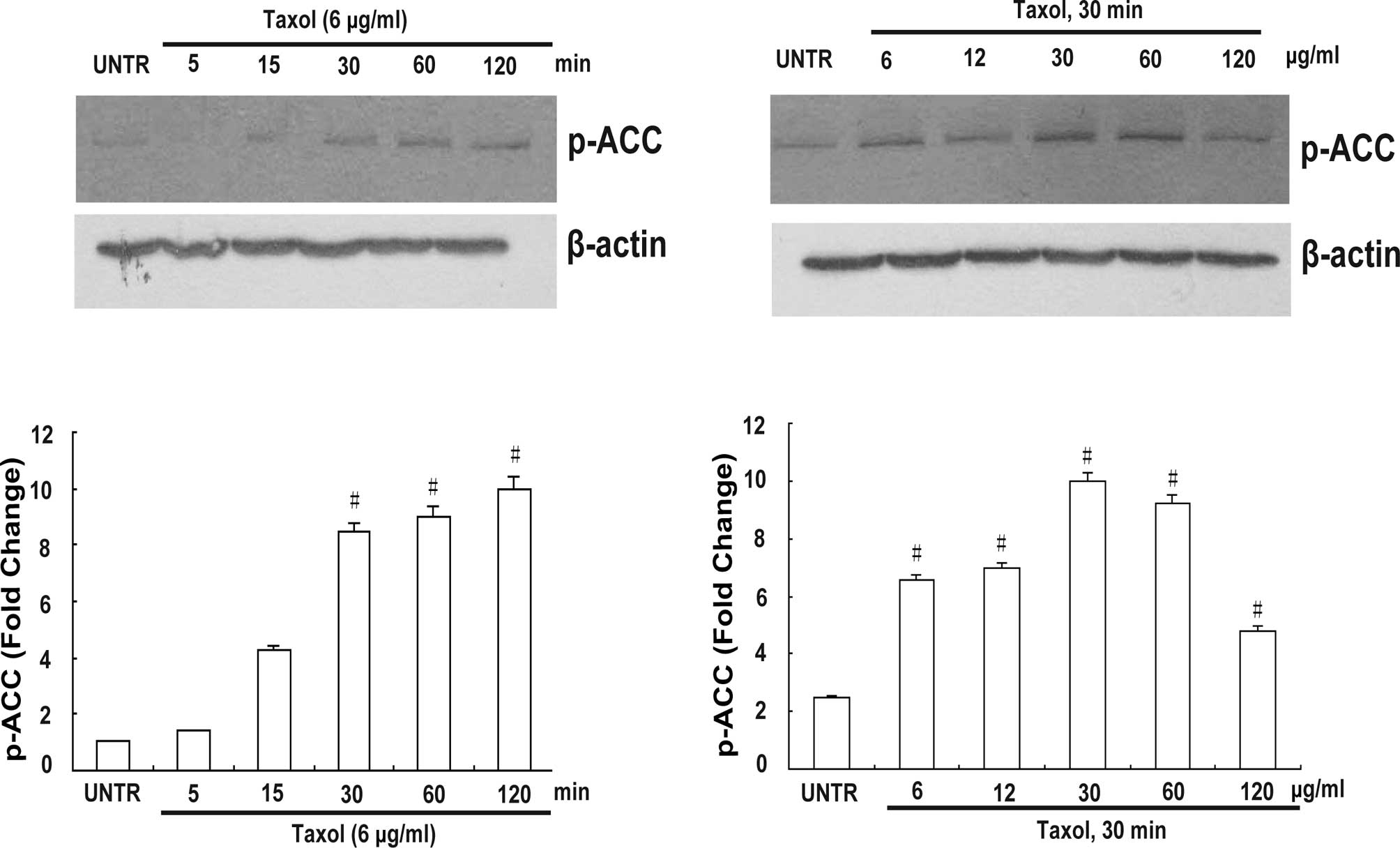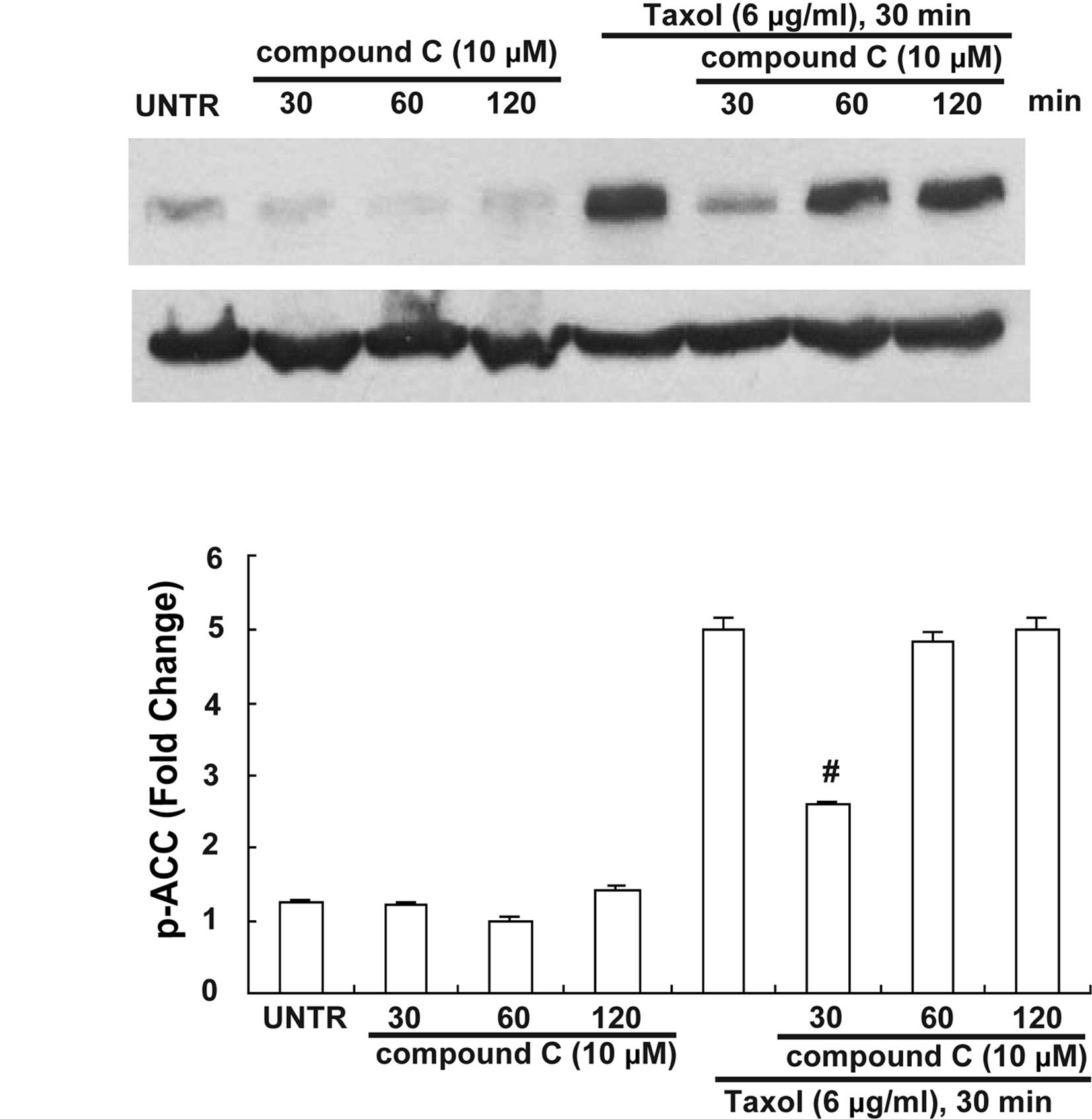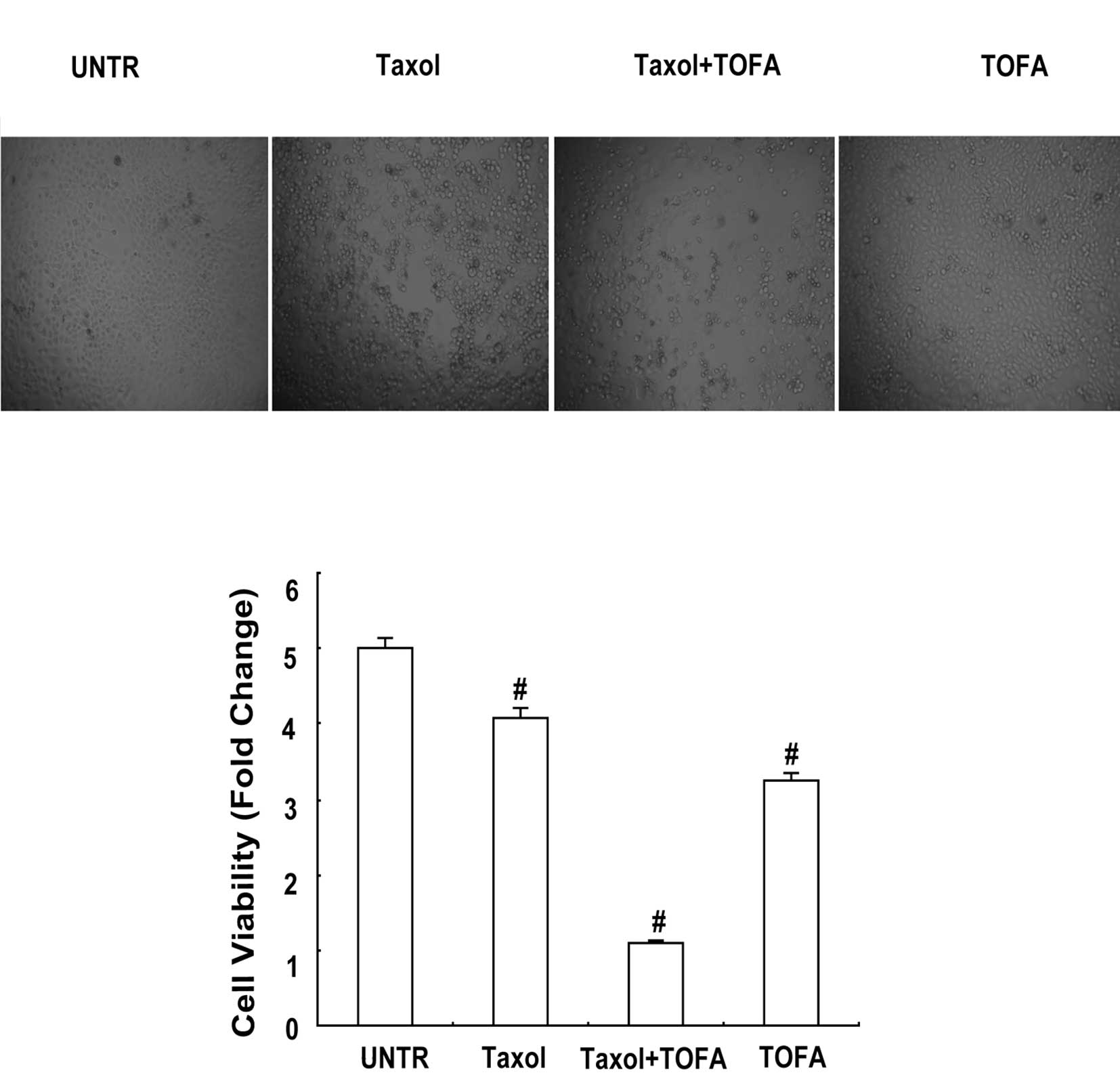Activation of acetyl-coenzyme A carboxylase is involved in Taxol-induced ovarian cancer cell death
- Authors:
- Published online on: March 21, 2011 https://doi.org/10.3892/ol.2011.286
- Pages: 543-547
Abstract
Introduction
Taxol or paclitaxel is a mitotic inhibitor used in cancer chemotherapy. It was first isolated from the bark of the Pacific yew tree, Taxus brevifolia, and termed ‘Taxol’ in 1967. Taxol functions by interfering with normal microtubule breakdown during cell division (1). Taxol has been shown to induce programmed cell death (apoptosis) in cancer cells by binding to an apoptosis-stopping protein called Bcl-2 (B-cell leukemia 2), thereby arresting its action.
One common characteristic of most cancer cells is their rapid rate of cell division. To accommodate this rapid cell division, the cytoskeleton of a cell undergoes extensive restructuring. Taxol is an effective treatment for aggressive cancers as it adversely affects the process of cell division by preventing this restructuring (2). Cancer cells are also destroyed by the aforementioned anti-Bcl-2 mechanism. Other cells are affected adversely. However, cancer cells divide more rapidly than non-cancer cells, rendering them more susceptible to Taxol treatment.
Taxol is one of the most active cancer chemotherapeutic agents. It is effective against a variety of human tumors including ovarian, breast and non-small-cell lung tumors, as well as head and neck carcinomas (1,3–6). However, its effectiveness is often limited due to resistance to Taxol, observed in many tumors (7). This study examined whether this resistance could be reduced.
Acetyl-CoA carboxylase (ACC) is a biotin-dependent enzyme that catalyzes the irreversible carboxylation of acetyl-CoA to produce malonyl-CoA. ACC plays a role in the regulation of the fatty mechanism. When the enzyme is active, malonyl-CoA is produced. Malonyl-CoA inhibits the transfer of the fatty acyl group from acyl CoA to carnitine with carnitine acyltransferase, which inhibits the β-oxidation of the fatty acid in mitochondria (8). The activity of ACC is regulated by the reversible phosphorylation.
ACC activity is inhibited when it is phosphorylated. The phosphorylation takes place when hormones, such as glucagon or epinephrine, bind to the receptors or the energy status of the cell is low, leading to the activation of AMPK (9). The presence of fatty acid inhibits the activities of the enzyme. When insulin binds to its cell receptors, it activates a phosphatase to dephosphorylate the enzyme thereby enhancing ACC activity (10). Recent studies have shown ACC to be an enzyme that plays a crucial role in de novo fatty acid biosynthesis and lipogenesis (11), and is essential for cancer cell survival (12). Inhibition of ACC induced the apoptosis of cancer cells (13,14).
This study investigated whether ACC is involved in Taxol-induced cell death in ovarian cancer cells and examined the cell signaling pathways associated with ACC inhibition. Results showed for the first time that Taxol induced ACC inhibition in ovarian cancer cells and that EGFR and AMPK are involved in ACC signaling. Consequently, ACC is considered to be a new molecular target of Taxol.
Materials and methods
Chemicals and reagents
PD153035, AG1478 and compound C were obtained from Calbiochem (San Diego, CA, USA). Goat anti-rabbit IgG-HRP and goat anti-mouse IgG-HRP antibodies were purchased from Santa Cruz Biotechnology (Santa Cruz, CA, USA). Monoclonal mouse anti-β-actin was obtained from Sigma (St. Louis, MO, USA). Anti-phospho-ACC (Ser79) and cleaved caspase-3 (Asp175) were obtained from Cell Signaling Technology (Beverly, MA, USA).
Cell culture
Human ovarian cancer cells (CaOV3 cells) were maintained in DMEM medium (Sigma) supplemented with 10% fetal bovine serum (FBS), penicillin/streptomycin (1:100, Sigma) and 4 mM L-glutamine, in a CO2 incubator at 37°C. For Western blotting, cells were seeded in 6-well plates at a density of 0.2×106 cells/ml with fresh complete culture medium.
Western blot analysis
As previously described (15–18), treated and untreated cultured cells were washed with cold PBS and harvested by scraping into 150 μl of RIPA buffer with protease inhibitors. Proteins (20–40 μg) were separated by SDS-PAGE and transfered onto PVDF membranes (Millipore, Bedford, MA, USA). After blocking with 10% milk in Tris-buffered saline (TBS), membranes were incubated with specific antibodies in dilution buffer (2% bovine serum albumin in TBS) overnight at 4°C followed by horseradish peroxidase-conjugated anti-rabbit or anti-mouse IgG at appropriate dilutions at room temperature for 1 h. Antibody binding was detected using an ECL detection system from Amersham Biosciences (Piscataway, NJ, USA) according to the manufacturer’s instructions and visualized by fluorography with Hyperfilm.
Cell viability assay (MTT dye assay)
Cell viability was measured by the 3-[4,5-dimethylthylthiazol-2-yl]-2,5 diphenyl- tetrazolium bromide (MTT) method. Briefly, cells were collected and seeded in 96-well plates at a density of 2×105 cells/cm2. After incubation for 24 h, cells were exposed to fresh medium containing reagents at 37°C. After incubation for a certain period, 20 μl of MTT tetrazolium (Sigma) salt dissolved in Hank’s balanced salt solution at a concentration of 5 mg/ml was added to each well and incubated in a CO2 incubator for 4 h. The medium was then aspirated from each well and 150 μl of DMSO (Sigma) was added to dissolve formazan crystals. The absorbance of each well was obtained using a Dynatech MR5000 plate reader at a test wavelength of 490 nm with a reference wavelength of 630 nm.
Results
Taxol induces ACC inhibition in CaOV3 ovarian cancer cells
This study examined whether Taxol induces ACC inhibition in human ovarian cancer cells. Cells were treated with 6 μg/ml Taxol at different time points (5, 15, 30, 60 and 120 min) or with Taxol at different concentrations (6, 12, 30, 60 and 120 μg/ml) for 30 min. Cell lysates were then analyzed for phospho-ACC by Western blotting as described above. As shown in Fig. 1, Taxol induced ACC inhibition in a time- and concentration-dependent manner. ACC inhibition was observed within 30 min and peaked at 120 min (Fig. 1A and B). Taxol at concentrations of 6, 12 and 30 μg/ml significantly induced ACC inhibition (Fig. 1C and D).
Effect of selective ACC inhibitor 5-(tetradecyloxy)-2-furoic acid (TOFA) mediates Taxol-induced ACC inhibition
We examined whether TOFA affects ACC signaling in the presence of Taxol. Taxol-induced ACC phosphorylation was enhanced by pretreatment with TOFA (10 μg/ml) for 30, 60 or 120 min. As shown in Fig. 2, TOFA enhanced ACC phosphorylation in a time-dependent manner in the presence of Taxol.
Effect of selective AMPK inhibitor compound C and selective AMPK activator AICAR on Taxol-induced ACC inhibition
AMPK is a significant up-stream signal of ACC, and Taxol activates AMPK in human ovarian cancer cells (19). To investigate the manner in which AMPK affects ACC inhibition in response to Taxol treatment, AMPK inhibitor compound C and activator AICAR were used. Our data showed that pretreatment with AMPK inhibitor compound C at 10 μM for 30 min but not 60 or 120 min blocked Taxol-induced ACC phosphorylation (Fig. 3), whereas Taxol-induced ACC phosphorylation was enhanced by pretreatment with AICAR at 1 mM for 30 min (Fig. 4).
PD (selective EGFR inhibitor) and AG (selective EGFR inhibitor) mediates Taxol-induced ACC activation
Numerous studies have shown that over-expression of EGFR is attributed to ovarian cancer cell resistance to Taxol-induced cell death (18,20). Since EGFR is a significant upstream signal of ACC and EGFR is also activated by Taxol in human ovarian cancer cells (18), the hypothesis that PD and AG were involved in ACC signaling in the presence of Taxol was examined. PD was shown to mediate ACC inhibition, since pretreatment with PD 1 μM for 30 min enhanced Taxol-induced ACC phosphorylation (Fig. 4). AG also mediated ACC inhibition, since pretreatment with AG 1 μM for 30 min enhanced Taxol-induced ACC phosphorylation (Fig. 4).
TOFA alleviates Taxol-induced cell death
TOFA was found to induce CaOV3 cell death. MTT dye assay was applied to investigate the anti-tumor effect of ACC inhibitor in CaOV3 cells. Taxol (6 μg/ml) and incubation for 24 h reduced cell viability by 81.47% (Fig. 5B). Cell viability was decreased to 64.70% by 10 μg/ml of TOFA and incubation for 24 h (Fig. 5B). Furthermore, cell viability was decreased to 21.65% when both Taxol (6 μg/ml) and TOFA (10 μg/ml) were administered, followed by incubation for 24 h (Fig. 5B). As shown in Fig. 5A, the difference was evident.
Discussion
Ovarian cancer is the most lethal cancer of the female reproductive system. Its high patient mortality rate can partly be attributed to a lack of early detection and screening. Despite good initial responses to chemotherapy, side effects and drug resistance are notable disadvantages of current chemotherapeutic agents. Subsequently, drugs with low toxicity and high efficiency have been in high demand.
Taxol is one such agent and has been administered to thousands of ovarian cancer patients. Taxol has been shown to inhibit transformation, proliferation and tumor metastasis. Carcinogenesis is a multistep process in which numerous biochemical pathways and hundreds of molecules are deregulated. These events include growth factors and their receptors, cytokines, enzymes and genes regulating apoptosis and proliferation.
Taxol has been shown to target a number of the molecules involved in carcinogenesis, including transcription factors such as AMPK and similar protein kinases. Moreover, Taxol has been found to be targeting EGFR in CaOV3 cells (18). Exploration of Taxol’s molecular targets has aided in the understanding of its pharmacological effects and has also provided experimental data with which its clinical application can be guided.
In the present study, ACC was found to be another molecular target of Taxol in CaOV3 ovarian cancer cells. ACC is phosphorylated simultaneously by Taxol treatment, thereby confirming ACC inhibition. p-ACC has been shown to be an independent marker for prediction of better survival in lung adenocarcinoma patients. Median overall survival was longer in patients with p-ACC-positive than those with p-ACC-negative tumors (21).
Taxol induced ACC phosphorylation in CaOV3 ovarian cancer cells. Phospho-ACC was enhanced by pretreatment with TOFA, a selective inhibitor of ACC. Notably, Taxol-induced cell death was increased by pretreatment with TOFA. Apoptosis in CaOV3 cells was even induced by TOFA administration alone. ACC is therefore a crucial target in CaOV3 ovarian cancer cell apoptosis.
AMPK is considered to be an important component of apoptosis, as well as a possible target of cancer control. Kim et al showed that activation by AICAR increased apoptosis in HT-29 colon cancer cells under capsaicin treatment. Additionally, both the activation of AMPK and an increased expression of the inactive form of ACC were detected in the apoptosis process of colon cancer cells (22).
Pretreatment with Compound C, a selective AMPK inhibitor almost abolished ACC phosphorylation by Taxol. However, ACC phosphorylation by Taxol was enhanced by AICAR, a selective AMPK activator. The results therefore indicate that AMPK lies upstream of ACC, and the AMPK activator has been noted to contribute to ACC inhibition.
In a previous study, Taxol was found to transiently transactivate EGFR, leading to the activation of cell survival factors, all of which are inclusively accountable for ovarian cancer cell resistance to Taxol treatment. A combination of Taxol with inhibitors such as PD and AG may be a more viable option for ovarian cancer treatment (18).
ACC phosphorylation by Taxol was found to have been enhanced following pretreatment with the selective EGFR inhibitors PD and AG. The reason that a combination of PD and AG with Taxol is a more feasible option for ovarian cancer treatment has been indicated by the ACC pathway. ACC inhibition may be up-regulated by PD and AG, which in turn increases Taxol-induced CaOV3 cancer cell apoptosis.
In conclusion, ACC has been shown for the first time to be a new molecular target for Taxol. Moreover, ACC inhibition partially accounts for the cell apoptosis of Taxol-induced cytotoxicity in ovarian cancer cells. Agents that potentially enhance ACC inhibition and then block the cell survival process were also investigated. Taxol-induced cell death may be reduced by agents such as PD, AG, AICAR and TOFA. Our findings indicate that insights into understanding the molecular mechanism of Taxol’s effect on CaOV3 cancer cell death are required, which may offer better clinical management of ovarian cancer.
Acknowledgements
This study was partly supported by a grant from the National Natural Science Foundation of China (no. 30772306, WD) and partly by a grant from NIH (P20 RR016457 from the INBRE Program of the National Center for Research Resources, YW).
References
|
Rowinsky EK and Donehower RC: Paclitaxel (Taxol). N Engl J Med. 332:1004–1014. 1995. View Article : Google Scholar : PubMed/NCBI | |
|
Yvon AM, Wadsworth P and Jordan MA: Taxol suppresses dynamics of individual microtubules in living human tumor cells. Mol Biol Cell. 10:947–959. 1999. View Article : Google Scholar : PubMed/NCBI | |
|
McGuire WP, Rowinsky EK, Rosenshein NB, et al: Taxol: a unique antineoplastic agent with significant activity in advanced ovarian epithelial neoplasms. Ann Intern Med. 111:273–279. 1989. View Article : Google Scholar : PubMed/NCBI | |
|
Liebmann JE, Cook JA, Lipschultz C, et al: Cytotoxic studies of paclitaxel (Taxol) in human tumour cell lines. Br J Cancer. 68:1104–1109. 1993. View Article : Google Scholar : PubMed/NCBI | |
|
Eisenhauer EA and Vermorken JB: The taxoids. Comparative clinical pharmacology and therapeutic potential. Drugs. 55:5–30. 1998.PubMed/NCBI | |
|
Wiseman LR and Spencer CM: Paclitaxel. An update of its use in the treatment of metastatic breast cancer and ovarian and other gynaecological cancers. Drugs Aging. 12:305–334. 1998.PubMed/NCBI | |
|
Sangrajrang S and Fellous A: Taxol resistance. Chemotherapy. 46:327–334. 2000. View Article : Google Scholar | |
|
Tong L: Acetyl-coenzyme A carboxylase: crucial metabolic enzyme and attractive target for drug discovery. Cell Mol Life Sci. 62:1784–1803. 2005. View Article : Google Scholar : PubMed/NCBI | |
|
Wakil SJ and Abu-Elheiga LA: Fatty acid metabolism: target for metabolic syndrome. J Lipid Res. 50:S138–S143. 2009. View Article : Google Scholar : PubMed/NCBI | |
|
Tong L and Harwood HJ Jr: Acetyl-coenzyme A carboxylases: versatile targets for drug discovery. J Cell Biochem. 99:1476–1488. 2006. View Article : Google Scholar : PubMed/NCBI | |
|
Ronnebaum SM, Joseph JW, Ilkayeva O, et al: Chronic suppression of acetyl-CoA carboxylase 1 in beta-cells impairs insulin secretion via inhibition of glucose rather than lipid metabolism. J Biol Chem. 283:14248–14256. 2008. View Article : Google Scholar : PubMed/NCBI | |
|
Swinnen JV, Brusselmans K and Verhoeven G: Increased lipogenesis in cancer cells: new players, novel targets. Curr Opin Clin Nutr Metab Care. 9:358–365. 2006. View Article : Google Scholar : PubMed/NCBI | |
|
Bandyopadhyay S, Zhan R, Wang Y, et al: Mechanism of apoptosis induced by the inhibition of fatty acid synthase in breast cancer cells. Cancer Res. 66:5934–5940. 2006. View Article : Google Scholar : PubMed/NCBI | |
|
Chajes V, Cambot M, Moreau K, et al: Acetyl-CoA carboxylase alpha is essential to breast cancer cell survival. Cancer Res. 66:5287–5294. 2006. View Article : Google Scholar : PubMed/NCBI | |
|
Qiu L, Zhou C, Sun Y, et al: Crosstalk between EGFR and TrkB enhances ovarian cancer cell migration and proliferation. Int J Oncol. 29:1003–1011. 2006.PubMed/NCBI | |
|
Qiu L, Zhou C, Sun Y, et al: Paclitaxel and ceramide synergistically induce cell death with transient activation of EGFR and ERK pathway in pancreatic cancer cells. Oncol Rep. 16:907–913. 2006.PubMed/NCBI | |
|
Zhou C, Qiu L, Sun Y, et al: Inhibition of EGFR/PI3K/AKT cell survival pathway promotes TSA’s effect on cell death and migration in human ovarian cancer cells. Int J Oncol. 29:269–278. 2006.PubMed/NCBI | |
|
Qiu L, Di W, Jiang Q, et al: Targeted inhibition of transient activation of the EGFR-mediated cell survival pathway enhances paclitaxel-induced ovarian cancer cell death. Int J Oncol. 27:1441–1448. 2005.PubMed/NCBI | |
|
Aissat N, Le Tourneau C, Ghoul A, et al: Antiproliferative effects of rapamycin as a single agent and in combination with carboplatin and paclitaxel in head and neck cancer cell lines. Cancer Chemother Pharmacol. 62:305–313. 2008. View Article : Google Scholar : PubMed/NCBI | |
|
Qiu L, Wang Q, Di W, et al: Transient activation of EGFR/AKT cell survival pathway and expression of survivin contribute to reduced sensitivity of human melanoma cells to betulinic acid. Int J Oncol. 27:823–830. 2005.PubMed/NCBI | |
|
Conde E, Suarez-Gauthier A, Garcia-Garcia E, et al: Specific pattern of LKB1 and phospho-acetyl-CoA carboxylase protein immunostaining in human normal tissues and lung carcinomas. Hum Pathol. 38:1351–1360. 2007. View Article : Google Scholar : PubMed/NCBI | |
|
Kim YM, Hwang JT, Kwak DW, et al: Involvement of AMPK signaling cascade in capsaicin-induced apoptosis of HT-29 colon cancer cells. Ann NY Acad Sci. 1095:496–503. 2007. View Article : Google Scholar : PubMed/NCBI |














